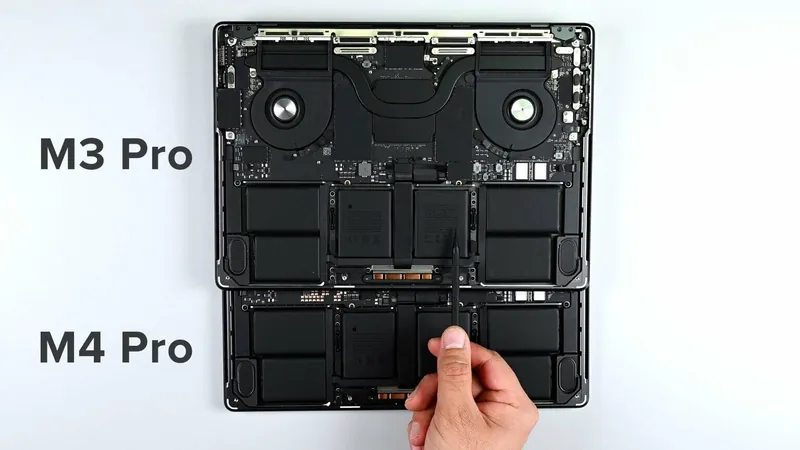
Apple’s M4 MacBook Pro: A Repairability Nightmare?
2024-11-25
Author: Nur
Introduction
The anticipation for Apple's M4 MacBook Pro was high, especially after rumors suggested that the tech giant was shifting towards more repair-friendly designs. However, recent revelations from the iFixit team indicate that this new device falls short of those expectations.
Repairability Scores
While Apple has made headlines for improved repairability scores in its recent releases, such as the iPhone 16 and the M4 Mac Mini, the M4 MacBook Pro seems to be an exception. Following their teardown of the device, the iFixit team expressed disappointment over the repairability of the newest MacBook.
With an increasing focus on creating thinner and lighter devices, Apple has once again resorted to excessive glue and challenging screw placements, resulting in a complex repair process for users.
Comparing Recent Releases
The initial excitement regarding Apple's advancements was fueled by features in the iPhone 16, which allowed for easier battery replacements thanks to a debonding adhesive activated by electrical currents. Similarly, the M4 Mac Mini offered easily accessible storage and a removable CMOS battery without requiring soldering tools.
With such positive trends, many were hopeful that the M4 MacBook Pro would continue this momentum — a hope that quickly dissipated upon inspection.
Challenges in Replacement
It turns out that replacing the battery in the M4 MacBook Pro is as tricky as it was for its predecessor. Despite promising potential, the soldered storage and a labor-intensive disassembly process remain major stumbling blocks.
iFixit’s analysis revealed that accessing the battery necessitates the removal of numerous screws and components, including the trackpad and adhesive tabs, a task that is daunting for the average user.
Modularity vs. Soldering
Interestingly, while many ports on the device are modular, the soldered nature of the storage means that users may face the frustrating scenario of needing to replace an entire laptop instead of simply upgrading a failed component.
This decision by Apple raises eyebrows, as it seems to stem less from technological constraints and more from a reluctance to innovate the MacBook Pro's design. For enterprise users, this may even push them towards exploring competing brands that offer easier repairs.
Pending Repairability Score
Though iFixit's detailed repairability score for the M4 MacBook Pro is still pending, the complexity of the hardware suggests it might mirror the previous model's disappointing 4 out of 10.
An iFixit representative highlighted persistent issues with parts pairing and calibration, which complicate repairs: “Batteries and ports are relatively repair-friendly, but swapping displays or logic boards is a minefield of software locks. While Apple has indicated a desire to address these barriers, practical improvements remain to be seen.”
Conclusion
In summary, Apple's M4 MacBook Pro appears to be caught in a dilemma between sleek design and user-friendliness. As debate surrounds the balance of aesthetics versus practicality, one thing is for sure: this latest addition to Apple's lineup has raised the stakes in the ongoing conversation about electronic repairability.
Will Apple listen to user concerns and adapt its strategy? Only time will tell!



 Brasil (PT)
Brasil (PT)
 Canada (EN)
Canada (EN)
 Chile (ES)
Chile (ES)
 España (ES)
España (ES)
 France (FR)
France (FR)
 Hong Kong (EN)
Hong Kong (EN)
 Italia (IT)
Italia (IT)
 日本 (JA)
日本 (JA)
 Magyarország (HU)
Magyarország (HU)
 Norge (NO)
Norge (NO)
 Polska (PL)
Polska (PL)
 Schweiz (DE)
Schweiz (DE)
 Singapore (EN)
Singapore (EN)
 Sverige (SV)
Sverige (SV)
 Suomi (FI)
Suomi (FI)
 Türkiye (TR)
Türkiye (TR)